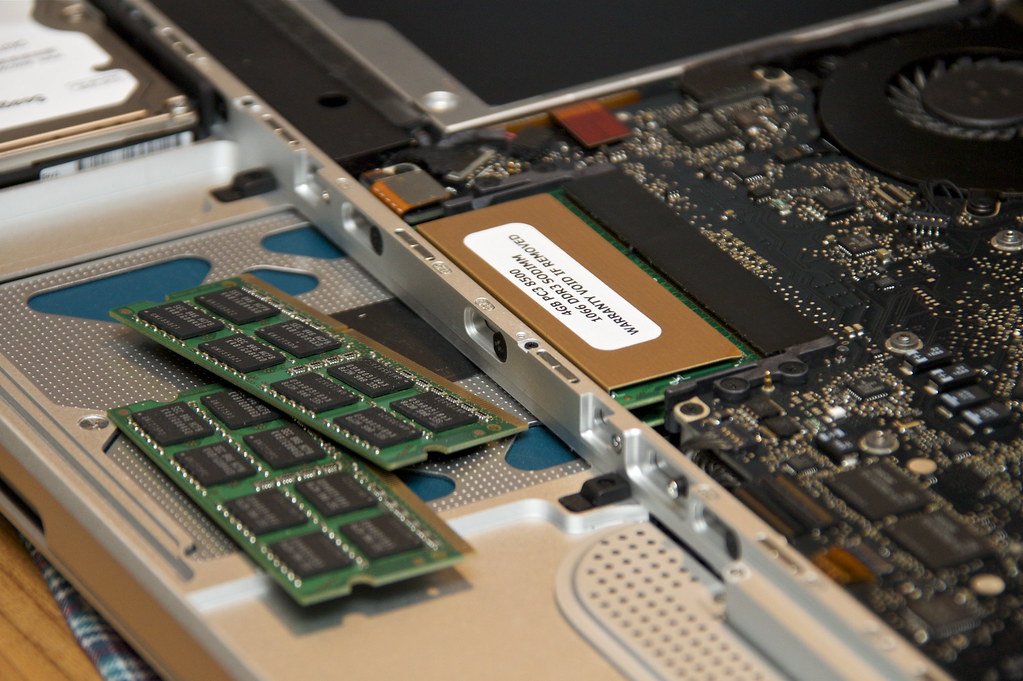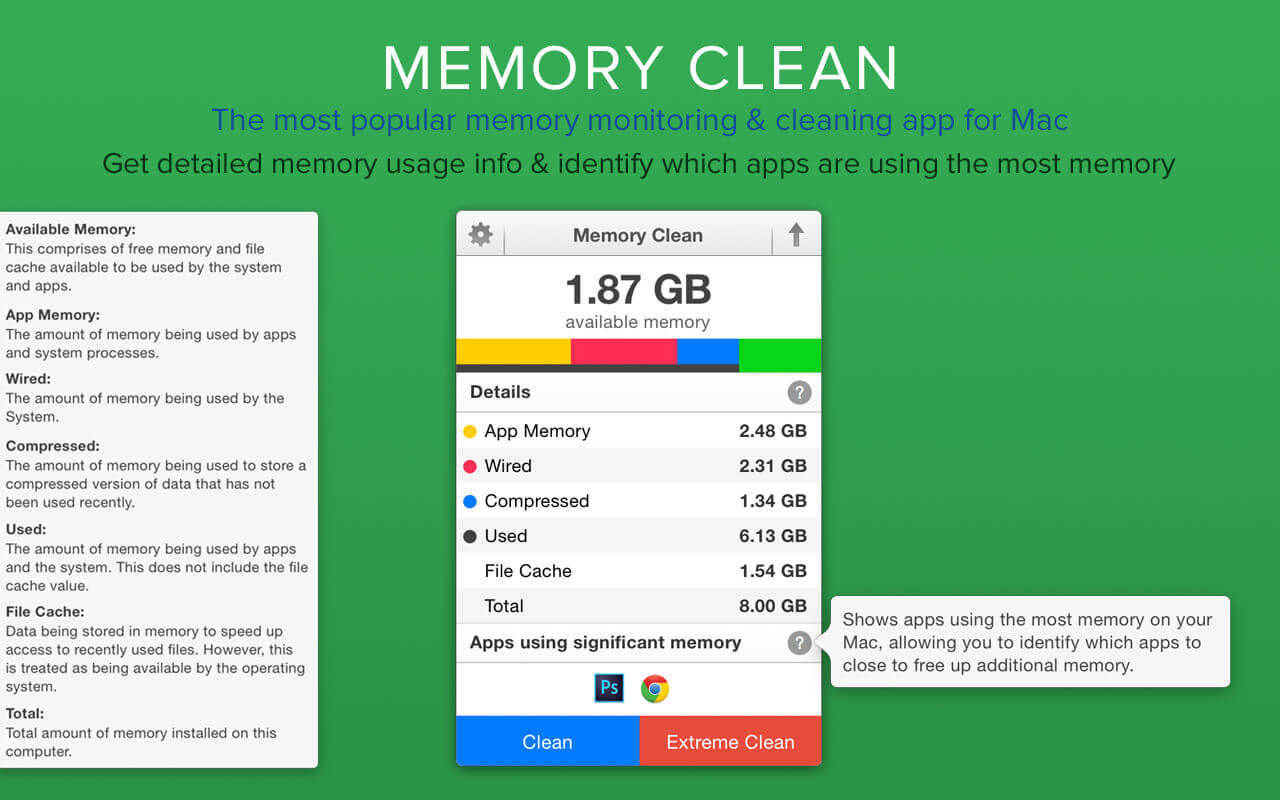Feb 06, 2020 Memory Cleaner is ABSOLUTELY FREE and allows you to automatically clean up inactive memory and speed up your Mac. Follow these steps to clear RAM with Memory Cleaner: Launch Memory Cleaner. The app will constantly be active from the toolbar on your desktop, displaying the used memory. In Preferences set up the frequency of automatic memory cleanup. You can try the memorypressure command. See the output of my system (i5, 4 GB RAM) The system has (524288 pages with a page size of 4096). Stats: Pages free: 90009 Pages purgeable: 139593 Pages purged: 7496548 Swap I/O: Swapins: 470466 Swapouts: 530913 Page Q counts: Pages active: 407739 Pages inactive: 148277 Pages speculative: 16200 Pages throttled: 0 Pages wired down: 263064. It still does it. I end up with around 30MB of free RAM, a reasonable amount of active RAM, and a massive amount of inactive RAM after a few days, then my computer slows down a lot. I have to keep flushing the inactive RAM with a memory cleaning tool or else my computer slows to a crawl. Repairing the permissions is supposed to clean out the.
The Optimised Storage features of your Mac help you save storage space by storing your content in iCloud and making it available on demand:
- When storage space is needed, files, photos, films, email attachments and other files that you rarely use are stored in iCloud automatically.
- Each file stays exactly where you last saved it, and will be downloaded when you open it.
- Files that you’ve used recently remain on your Mac, along with optimised versions of your photos.
If you haven't yet upgraded to macOS Sierra or later, find out about other ways to free up storage space.
Find out how much storage is available on your Mac
Choose Apple menu > About This Mac and then click Storage. Each segment of the bar is an estimate of the storage space used by a category of files. Move your pointer over each segment for more detail.
Click the Manage button to open the Storage Management window, pictured below.
Manage storage on your Mac
Free Up Inactive Memory Mac Free
The Storage Management window offers recommendations for optimising your storage. If some recommendations have already been turned on, you will see fewer recommendations.

Store in iCloud
Click the Store in iCloud button and then choose from these options:
- Desktop and Documents. Store all files from these two locations in iCloud Drive. When storage space is needed, only the files you've opened recently will be kept on your Mac, so you can work offline easily. Files stored only in iCloud display a download icon , which you can double-click to download the original file. Learn more about this feature.
- Photos. Store all original, full-resolution photos and videos in iCloud Photos. When storage space is needed, only space-saving (optimised) versions of photos are kept on your Mac. To download the original photo or video, just open it.
- Messages. Store all messages and attachments in iCloud. When storage space is needed, only the messages and attachments you recently opened are kept on your Mac. Find out more about Messages in iCloud.
Storing files in iCloud uses the storage space in your iCloud storage plan. If you reach or exceed your iCloud storage limit, you can either buy more iCloud storage or make more iCloud storage available. iCloud storage starts at 50 GB for US$0.99 a month, and you can purchase additional storage directly from your Apple device. Find out more about the prices in your region.
Optimise Storage
Click the Optimise button to save space by automatically removing films and TV programmes you've watched. When storage space is needed, films or TV programmes that you've purchased from Apple and have already watched will be removed from your Mac. Click the download icon next to a film or TV programme to download it again.
Your Mac will also save space by only keeping recent email attachments on this Mac when storage space is needed. You can manually download any attachments at any time by opening the email or attachment, or saving the attachment to your Mac.
Optimising storage for films, TV programmes and email attachments doesn't require iCloud storage space.
Empty Bin Automatically
Free Up Memory Mac
Empty Bin Automatically permanently deletes files that have been in the Bin for more than 30 days.
Reduce Clutter
Reduce Clutter helps you identify large files and files you may no longer need. Click the Review Files button and then choose any of the file categories in the sidebar, such as Applications, Documents, Music Creation or Bin.

You can delete the files in some categories directly from this window. Other categories show the total storage space used by the files in each app. You can then open the app and decide whether to delete files from within it.
Find out how to re-download apps, music, films, TV programmes and books.
Where to find the settings for each feature
The button for each recommendation in the Storage Management window affects one or more settings in other apps. You can also control these settings directly within each app.
- If you're using macOS Catalina or later, choose Apple menu > System Preferences, click Apple ID and then select iCloud in the sidebar: store in iCloud will turn on the Optimise Mac Storage setting on the right. To turn off iCloud Drive entirely, deselect iCloud Drive.
- If you're using macOS Mojave or earlier, choose Apple menu > System Preferences, click iCloud, then click Options next to iCloud Drive. Store in iCloud turns on the Desktop & Documents Folders and Optimise Mac Storage settings.
- In Photos, choose Photos > Preferences and then click iCloud. Store in iCloud selects iCloud Photos and Optimise Mac Storage.
- In Messages, choose Messages > Preferences, then click iMessage. Store in iCloud selects Enable Messages in iCloud.
- If you're using macOS Catalina or later, open the Apple TV app, choose TV > Preferences from the menu bar, then click Files. Optimise Storage selects “Automatically delete watched films and TV programmes”.
- If you're using macOS Mojave or earlier, open iTunes, choose iTunes > Preferences from the menu bar, then click Advanced. Optimise Storage selects “Automatically delete watched films and TV programmes”.
- In Mail, choose Mail > Preferences from the menu bar and then click Accounts. In the Account Information section on the right, Optimise Storage sets the Download Attachments menu to either Recent or None.
Empty Bin Automatically: From the Finder, choose Finder > Preferences, then click Advanced. Empty Bin Automatically selects “Remove items from the Bin after 30 days”.

Other ways that macOS automatically helps to save space
With macOS Sierra or later, your Mac will take these additional steps automatically to save storage space:
- Detects duplicate downloads in Safari, keeping only the most recent version of the download
- Reminds you to delete used app installers
- Removes old fonts, languages and dictionaries that aren't being used
- Clears caches, logs and other unnecessary data when storage space is needed
How to free up storage space manually
Even without using the Optimised Storage features described in this article, you can take other steps to make more storage space available:
- Music, films and other media can use a lot of storage space. Learn how to delete music, films and TV programmes from your device.
- Delete other files that you no longer need by moving them to the Bin, then emptying the Bin. The Downloads folder is good place to look for files that you may no longer need.
- Move files to an external storage device.
- Compress files.
- Delete unneeded email: In the Mail app, choose Mailbox > Erase Junk Mail. If you no longer need the email in your Deleted Items mailbox, choose Mailbox > Erase Deleted Items.
Learn more
- The Storage pane of About This Mac is the best way to determine the amount of storage space available on your Mac. Disk Utility and other apps may display storage categories, such as Not Mounted, VM, Recovery, Other Volumes, Other, Free or Purgeable. Don't rely on these categories to understand how to free up storage space or how much storage space is available for your data.
- When you duplicate a file on an APFS-formatted volume, that file won't use additional storage space on the volume. Deleting a duplicate file only frees up the space required by any data that you might have added to the duplicate. If you no longer need any copies of the file, you can recover all of the storage space by deleting both the duplicate and the original file.
- If you're using a pro app and Optimise Mac Storage, find out how to make sure your projects are always on your Mac and that you're able to access their files.